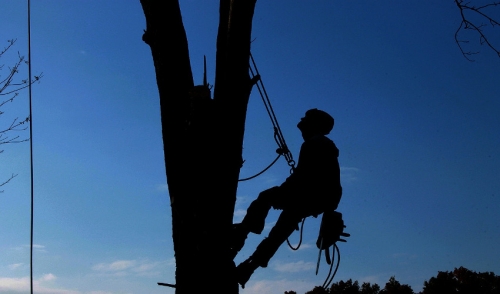{article.name}
Surfside Equipment Rental & Sales
Tips for Cutting Down a Tree Safely for the DIYer

- Share this:
- Share on Facebook
- Pin on Pinterest
- Tweet on Twitter
There are some who may argue that cutting down a tree safely is not possible. Chainsaws can be quite dangerous, not to mention felling trees. Though intimidating, a chainsaw is still just a tool. As long as it is handled correctly and safety guidelines are followed, a chainsaw can be as safe as any other tool.
Felling trees is often considered an art unto itself; something that squarely falls into the “easy to learn, difficult to master” category. Therefore, you should think about the size of the tree that you wish to take down. If the tree is large, or if there are any obstructions or structures that could be damaged, it may be best to err on the side of caution and consult or hire an expert. Most DIY’ers, however, should not have any problems removing a relatively small tree. To get the job done, we’ve included a few tips below.
If you haven’t already, familiarize yourself with the chainsaw. Thoroughly read the owner’s manual and make yourself aware of all of its safety features. Take the time to make some practice cuts on scrap wood, as well. The Occupational Safety and Health Administration (OSHA) stresses the importance of wearing proper protective gear. This includes a hard hat, eye and ear protection, long sleeve shirt, pants, work gloves and steel toed boots. They also advise to not cut anything above your head and to ensure that you have solid footing, with both hands on the saw before making a cut. OSHA has a fact sheet about chainsaw safety here.
Take a close look at the tree that you want to cut down. Ideally, choose a day when the weather is relatively calm, with as little wind is possible. Step back, study the tree and try to determine which direction it should fall. If the tree is leaning in one direction or appears to be heavier on one side, this should be relatively easy to discern. To help direct smaller trees, attach a rope and apply tension in the direction that you wish the tree to fall. How much tension will be determined by the natural lean of the tree in relation to the direction you wish it to go. At this point, once you are aware of the way that the tree will go, make sure that there are no obstructions on the way down. For example, wires, structures, landscaping, people or pets.
Even with all of this planning, it is still a good idea to have an escape route if the tree does not behave the way you intended. An ill-timed gust of wind, for example can have an effect on trajectory once things start rolling. Take the time to clear the area around the tree so that you have an easy exit if need be.
Sometimes it’s necessary to cut a hinge or wedge to direct the way that the tree will go. This is done by cutting a 20° upward angle on the side of the tree that faces the direction you want it to fall. This cut should be equal to one quarter of the tree’s diameter. For example, an 8 inch tree would require a 2 inch wedge to be cut. Next, make a second cut a few inches above the first one at a 70° downward angle until it meets your first cut, forming a wedge. A third cut should be made on the opposite side of the tree. This cut has no angle and will be parallel to the ground. Cut towards the wedge. As you go, pause about halfway and assess the situation. Make sure everything is behaving the way it’s supposed to. When it comes to cutting down trees, situational awareness is a good thing, so don’t lose sight of your escape route. Continue cutting, if all is well, and once the tree begins to fall, step away and let it go.


Comments